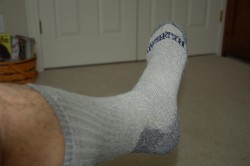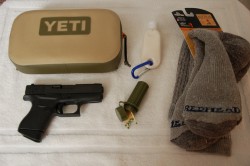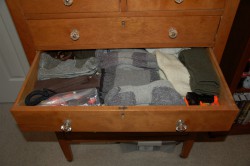
The oft quoted proverb “Don’t sweat the small stuff, but it’s all small stuff,” often ignores the common sense point that sometimes forgetting to take care of some of the small stuff items and concerns could end up being a big deal. And more often than not it turns out some small stuff thing is what causes a breakdown in the success of a survival effort.
One of those “small stuff” items is foot care, and in particular socks. You know, those warm, fuzzy, comfy layers of Godsend that surrounds your feet with warmth, insulation, abrasion resistance, and just plain ole comfort. I mean, try wearing hiking boots or even camp shoes without socks for a day and the mistake could haunt you for a while.
Every day socks are an innocuous sort of thing we all take for granted.
At home we just open up the “sock drawer” and take out a pair without much thought. Ever wonder why an entire drawer in your dresser or closet has been labeled and dedicated to just socks? That alone should tell us something. This clothing item has a whole wardrobe drawer to itself. It must mean they play a very important role in our dressing choices. For sure.
Sock Materials

Socks are made from a lot of different materials. The prevailing fiber contents are usually cotton, wool, or some kind of synthetics like polyester, rayon or nylon or something we’ve likely never heard of. There are reasons for all of these fiber content mixes, but choose carefully for the intended tasks for the day. A nylon blend in socks will increase long term wear especially in the toes and heels.
Also Read: 5 Shoe Types for SHTF
Often it is the weather, temperature, and the activity level that should dictate the types of socks to wear. If it is simple outdoor walking, puttering around the yard, grocery shopping, or other standard daily tasks, then plain ole cotton or athletic type socks usually serve well. This may also be directed by the type of footwear being worn as well.
If the weather is cold, and the outside work prolonged or arduous, then a wool sock or wool blend is the way to go. Wool keeps feet warm even when wet, though nobody really likes to stay in wet socks for very long. If hiking, hunting, fishing, chopping wood, or walking a fence line on Bug Out patrol duty, then wool socks will serve well in cold and damp conditions.
Again, also match the footwear to the duty choosing insulated and waterproof boots and shoes. Sock weight or thickness may also play a role. Gauge the thickness of the socks you pick to wear again by activity and duration along with the type of shoes or boots to be worn that day or period of time.
Sock Fit

Just like when picking out a pair of shoes or boots to purchase to make certain the size and fit are correct, the same is true for socks. In most cases, socks are generally woven to cover a range of sizes within the common designations of S-M-L-XL. Make sure you read the sock packaging to find the correct sizing range for your foot fit. Unfortunately, not all sock brands may fit the same within the same size indicated.
Related: Best Boots for Bugging Out
When picking a size, first avoid socks that are too small or way too big. Small socks may restrict free toe movement and the tops may be so tight they cut off circulation above the ankles. When you remove socks and there are signs of deep elastic impressions on the skin, then the socks are probably too small, and hence too tight.
The same can be said for socks that are excessively large on the foot. This may cause the socks to move around inside the footwear causing material to bunch up and even elevate the creation of blisters. Abrasion causes blisters and other feet problems when socks shift or move back and forth with each step.
Best fitting socks should be form fitting to the outline of the foot. The toes should be able to move and wiggle freely for good blood circulation. Socks should fit well at the ankles and on the heel. Sock tops should not be too tight as mentioned, but form fitting enough to help keep the socks from eventually sliding down into the boots or shoes.
Even the best fitting socks will tend to move around or slip down. If the task is a long one, it is advisable to stop to readjust the socks in the footwear then continue. For certain, do not let the socks slip down below the heels. Pulling socks up from time to time might help, but often the shoes have to be removed to completely adjust their fit again.
Socks Life

Socks just like all other clothing items do wear out eventually. Ratty socks with holes or worn thin areas should be tossed or repurposed for some other uses, cleaning, or stuffing the dog bed or pillows, etc. Naturally socks just wear out from use, but wear is facilitated more quickly if not washed regularly and dried out completely. Bad socks should be replaced. Besides they make great stocking (pun intended) stuffers at Christmas and for birthdays. All preppers like fresh, new socks.
It is often advised to never wear the same footwear two days in a row if possible to let them dry out completely, as well as toothbrushes, so perhaps this is good advice for socks as well. Boot dryers can also be used for socks and gloves by the way. Turning socks inside out after each use will also increase drying time and just airing them out will aid in longevity, not to mention scent control.
There are many, many brands of socks some rather generic, and others by well-known names. You probably know your own favorites. The trick though is to fit them properly, and to take care of them. Buy fresh ones often as needed. They are a cheap investment in foot care and comfort. Socks are a vital component to successful prepping and survival. Just try doing without them.
2 comments
a thin pair of polyester “liner” socks, under your regular socks, is helpful sometimes.
(especially if the feel of wool bothers you)
I wear them seam side out, so the smoothest part is against my skin. blistered feet can criple you for a week, without a SHFT to deal with on top of everything else…
wear more wool!
the sheep are not harmed. they get it, they benefit from the haircut. we benefit from the wool. “merino” is a key word. merino wool is primo stuff. very nice, soft.
if you won’t wear wool, then an acryllic blend is IMHO, the next best thing.
NOTE: you are paying a premium price for good socks. DON’T put them in the DRYER. put on your Big Boy (or Big Girl) Pants, and learn to do your Survivalist Laundry like a GROWN-UP.
I love the feel of new socks, especially merino wool new socks. I started buying Darn Tough socks. Short ones for summer, boot length for winter. Yes, they are $15-20 per pair, but they have a lifetime warranty. I have sent 15 pairs back for new replacements. The cost per pair goes down pretty quick. I have about 20 pairs and I will never buy socks again. Ever.